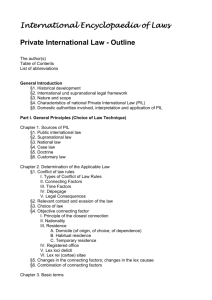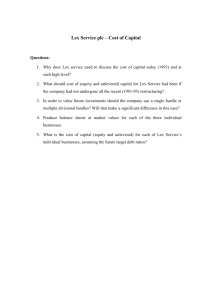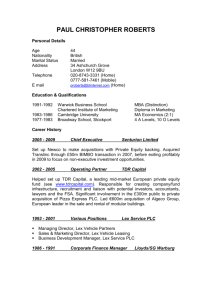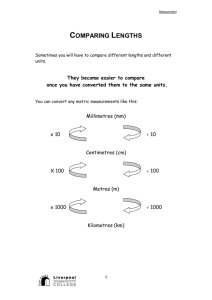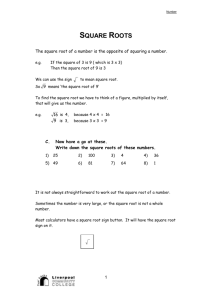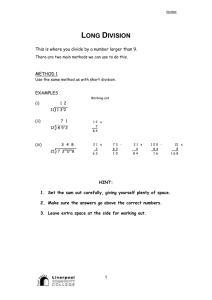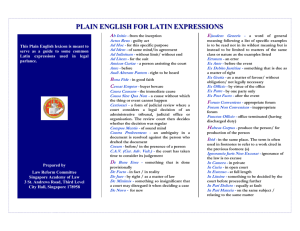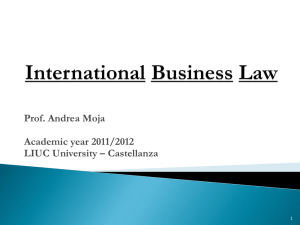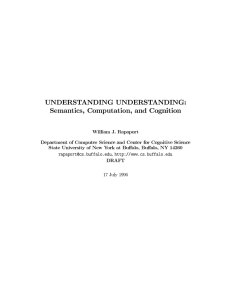Private International Law - CER
advertisement
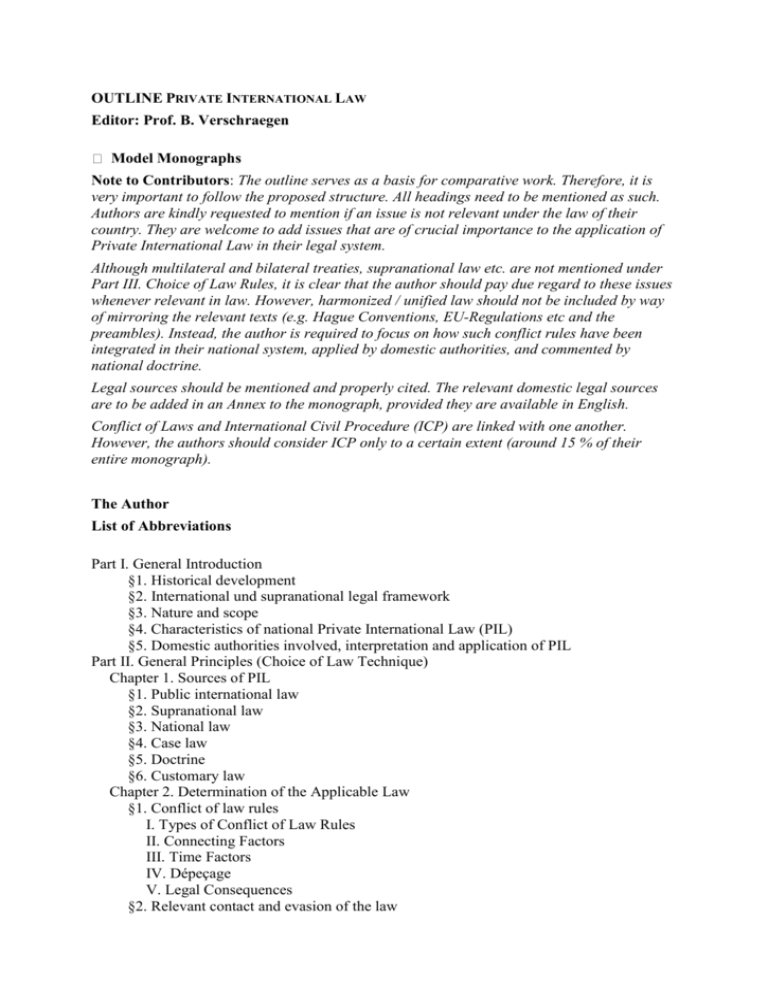
OUTLINE PRIVATE INTERNATIONAL LAW Editor: Prof. B. Verschraegen Model Monographs Note to Contributors: The outline serves as a basis for comparative work. Therefore, it is very important to follow the proposed structure. All headings need to be mentioned as such. Authors are kindly requested to mention if an issue is not relevant under the law of their country. They are welcome to add issues that are of crucial importance to the application of Private International Law in their legal system. Although multilateral and bilateral treaties, supranational law etc. are not mentioned under Part III. Choice of Law Rules, it is clear that the author should pay due regard to these issues whenever relevant in law. However, harmonized / unified law should not be included by way of mirroring the relevant texts (e.g. Hague Conventions, EU-Regulations etc and the preambles). Instead, the author is required to focus on how such conflict rules have been integrated in their national system, applied by domestic authorities, and commented by national doctrine. Legal sources should be mentioned and properly cited. The relevant domestic legal sources are to be added in an Annex to the monograph, provided they are available in English. Conflict of Laws and International Civil Procedure (ICP) are linked with one another. However, the authors should consider ICP only to a certain extent (around 15 % of their entire monograph). The Author List of Abbreviations Part I. General Introduction §1. Historical development §2. International und supranational legal framework §3. Nature and scope §4. Characteristics of national Private International Law (PIL) §5. Domestic authorities involved, interpretation and application of PIL Part II. General Principles (Choice of Law Technique) Chapter 1. Sources of PIL §1. Public international law §2. Supranational law §3. National law §4. Case law §5. Doctrine §6. Customary law Chapter 2. Determination of the Applicable Law §1. Conflict of law rules I. Types of Conflict of Law Rules II. Connecting Factors III. Time Factors IV. Dépeçage V. Legal Consequences §2. Relevant contact and evasion of the law §3. Choice of law §4. Objective connecting factor I. Principle of the closest connection II. Nationality III. Residence A. Domicile (of origin, of choice, of dependence) B. Habitual residence C. Temporary residence IV. Registered office V. Lex loci delicti VI. Lex rei (cartae) sitae §5. Changes in the connecting factors; changes in the lex causae §6. Combination of connecting factors Chapter 3. Basic terms §1. Characterization (Classification) §2. Preliminary Question §3. Substance and Procedure §4. Renvoi §5. General Conflict Rule / Special Conflict Rule §6. Assimilation §7. Ordre Public (Public Policy) §8. Overriding Mandatory Rules §9. Evasion of the Law §10. Reference to the Law of States with Multiple Legal Orders Part III. Conflict of Law Rules Chapter 1. Persons §1. Natural Persons I. Legal Capacity II. Name III. Nationality / habitual residence / domicile IV. Stateless persons and refugees V. Transsexuals §2. Legal Persons I. Incorporated Organizations II. Unincorporated Organizations III. Scope of the lex societas IV. Liability V. Relocation VI. Cross-border transformation Chapter 2. Obligations §1. Contractual Obligations I. Party Autonomy II. Form III. Validity and Formation IV. Performance V. Breach of Contractual Obligations (including damages) VI. Rescission VII. Representation VIII. Interpretation IX. Third Parties and Multiparty Agreements X. Assignment and Subrogation §2. Particular Contracts I. Sales Contract II. Service Contract III. Consumer Contracts IV. Employment Contracts V. Contracts of Carriage A. Carriage of Persons B. Carriage of Goods VI. Insurance Contracts VII. IP Contracts A. Licence Agreement B. Trade Mark Agreement C. Other VII. Hybrid Contracts A. Leasing B. Factoring C. Franchise D. Publishing Contract E. Other VII. Negotiable Instruments A. Bills of Exchange B. Cheques C. Letters of Credit VIII. Agency Contracts §3. Non-Contractual Obligations I. Party Autonomy II. Objective Connection III. Law of Torts A. Lex loci delicti B. Scope of Application C. Damages (Compensation) D. Insurance and Social Security Law IV. Unfair Competition V. Negotiorum gestio VI. Unjust Enrichment VII. Culpa in contrahendo VIII. Other Chapter 3. Property §1. Lex rei sitae §2. Moveable Property I. Collateral II. Goods in Transit III. Cultural Property IV. Other §3. Immoveable Property I. Mortgage II. Immissions III. Easements §4. Securities §5. Trust §6. Expropriation Chapter 4. Intangible Property Rights §1. Rights of Personality I. Applicable Law II. Remedies §2. Patents I. Creation II. Protection III. Ownership and Transfer IV. Infringement §3. Copyright I. Creation II. Protection III. Ownership and Transfer IV. Infringement §4. Trademarks I. Creation II. Protection III. Ownership and Transfer IV. Infringement §5. Industrial Designs Chapter 5. Family Law §1. State Law – Religious Law §2. Marriage I. Engagement II. Heterosexual Marriage A. Form B. Substance III. Same-Sex Marriage A. Form B. Substance IV. Personal Effects of Marriage V. Dissolution A. Annulment B. Divorce C. Other §3. Matrimonial Property I. Choice of Law Agreement II. Relationship to Succession Law §4. Registered Partnership – Partnership / Civil Unions I. Personal Effects II. Dissolution III. Property §5. Extra-Marital Cohabitation I. Personal Effects II. Dissolution III. Property §6. Maintenance Law I. Spousal Maintenance II. Partnership Maintenance III. Maintenance of Cohabitees §7. Child Law I. Determination of Parenthood II. Custody and Contact III. Guardianship III. Adoption IV. Artificial Insemination, Surrogacy V. Child Support VI. Child Abduction §8. Protection of Adults Chapter 6. Succession Law §1. Lex successionis §2. Scope of Application §3. Testamentary Disposition I. Legal Capacity II. Choice of Law III. Compulsory Portion IV. Interpretation III. Last Will A. Formal Validity B. Substantive Validity IV. Legacy A. Formal Validity B. Substantive Validity V. Testamentary Contract A. Formal Validity B. Substantive Validity §4. Inheritance and Liability Part IV. Annex: International Civil Procedure Chapter 1. Sources of ICP Chapter 2. The principle of lex fori Chapter 3. National Jurisdiction Chapter 4. International Jurisdiction §1. Statutory Forums §2. Choice of Forum Agreement §3. Procedural Requirements §4. International Service §5. Rules of Evidence §6. Temporary Relief Chapter 5. Recognition and Enforcement of Foreign Decisions Chapter 6. International Insolvency Law Chapter 7. International Arbitration Table of Cases Table of Statutory Instruments Table of International Treaties Selected Bibliography Index ANNEX: National Legal Sources (English version)
